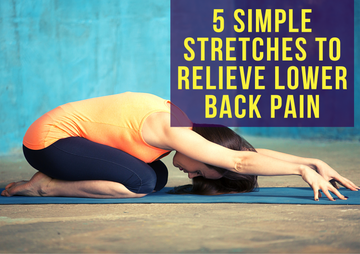5 Simple Stretches to Relieve Lower Back Pain
Minor lower back discomfort usually goes away on its own within a few days or weeks. When it lasts longer than three months, it is called chronic.
You may want to lay down, but exercising is healthy for your back. Lower back pain exercises can help to strengthen the muscles in the back, stomach, and legs. They support your spine and alleviate back discomfort.
While stretching isn't a cure-all for lower back discomfort, it can help in many cases.
If you've been experiencing slight soreness or stiffness in your lower back, these seven exercises may help relieve the pain and strengthen the muscles in your lower back.
In either case, staying physically active and stretching on a regular basis can help reduce or prevent lower back pain.
The rest of this article will walk you through five stretches for lower back pain that you can do at home with little or no equipment.
Stretching on a regular basis is an excellent approach to increase and maintain flexibility, relieve tension and help build strength.
First, a couple short pointers:
Stretch your lower back with caution. If you have an injury or a health problem, be extremely gentle and cautious. These stretches can be done once or twice a day. However, if the discomfort worsens or you're feeling really sore, take a day off from stretching.
Be aware of your body's limits and avoid pushing it too hard. Listen to your body and do what seems right for you at the time.
Before beginning any new forms of exercise, it is advisable to consult with your doctor beforehand.
1. Child's Pose
This classic yoga posture stretches your gluteus maximus, thigh muscles, and spinal extensors softly. It relieves pain and stress in your spine, neck, and shoulders.
Its calming impact on your body also aids in the relaxation of tense lower back muscles, encouraging flexibility and blood circulation down the spine.
Follow these instructions to do Child's Pose:
Sink back into your hips, resting them on your heels, with your hands and knees on the ground. Hinge at your hips as you fold forward and walk your hands out in front of you.
Place your belly on your thighs. Extend your arms in front of or along the side of your body, palms facing up. Concentrate on deep breathing and releasing any areas of tension or stiffness. Hold this stance for a minute.
This position may be repeated multiple times throughout your stretching regimen. Feel free to perform it in between your other stretches.
Modifications
If you need more support, throw a rolled-up towel on top of or beneath your thighs. Widen your knees and put your forehead on a cushion if it's more comfortable.
2. Knee-To-Chest
The knee-to-chest stretch can help extend your lower back and relieve discomfort and stress.
To do the knee-to-chest stretch, follow these steps:
1.Lie on your back, legs bent, and feet flat on the floor.
Grab your right lower leg with both hands and interlace your fingers, or clasp your wrists slightly below the knee.
2.Gently draw your right knee up to your chest while maintaining your left foot level on the floor until you feel a tiny stretch in your lower back.
Hold your right knee on your chest for 30-60 seconds, keeping your legs, hips, and lower back relaxed. Return to the beginning position by releasing your right knee. Steps 2-4 should be repeated with your left leg.
3. Piriformis Stretch
This stretch targets the piriformis muscle, which is located deep in the buttocks. This muscle can be stretched to help reduce discomfort and tightness in your buttocks and lower back.
Follow these Instructions:
Lie on your back, legs bent, and feet flat on the floor.
Position your right ankle near the bottom of your left thigh. Then, place your hands behind your left thigh and pull up toward your chest, feeling a stretch.
Maintain this posture for 30 seconds to 1 minute. Then repeat on the opposite side.
Keep your bottom foot grounded on the floor to make the stretch more pleasant. To provide support, place your head on a cushion.
4.Cat Cow Stretch
The cat-cow stretch is an effective exercise for increasing flexibility and relieving stress in the lower back and core muscles.
To do the cat-cow stretch, follow these steps:
Position yourself on your hands and knees, with your knees hip-width apart. This is your starting point. Pull your belly button up toward your spine, allowing your head to slide forward.
Hold the position for 5-10 seconds. A mild stretch should be felt in your lower back. Return to your starting point.
Raise your head and allow your pelvis to fall forward, bending your back toward the floor. This is the stretch with the cows. Return to the starting position after 5-10 seconds.
Repeat the cat-cow stretch 15-20 times. This exercise may also be done in a chair with your feet flat on the floor and your hands on your knees, making it ideal for squeezing in a few stretches at work.
Tight hamstrings (the muscles at the back of your thighs) are known to be a major cause of lower back discomfort and injury.
5. Seat Forward Bend
Tight hamstrings (the muscles at the back of your thighs) are known to be a major cause of lower back discomfort and injury.
The seat forward bend extends your hamstring muscles, releasing tension in your spine.
To do the seat forward bend, follow these steps:
Sit with your legs straight out in front of you on the floor.
Hook a regular bath towel over the soles of your feet, starting at the heels. Bend forward at the hips, bringing your belly button down to your thighs.
Grab the towel to assist you move your tummy closer to your legs while keeping your back straight. Stretch your legs until you feel slight tension on the back of your legs, and then hold for 30 seconds, then rest for 30 seconds before repeating three times.
By grasping the towel closer or farther away from your feet, you may adjust the intensity of this stretch. As your flexibility improves, you can lengthen the time you hold the stretch or shorten the time between stretches.
The Bottom Line
Lower back discomfort is a painful condition that affects many people.
These few exercises can assist in relieving persistent lower back discomfort!
You utilize your lower back for a variety of activities, including walking and jogging, as well as just getting out of bed in the morning.
Stretching on a regular basis is an excellent approach to increase and maintain flexibility, relieve tension and help build strength!
Our hand-picked favorites!



















